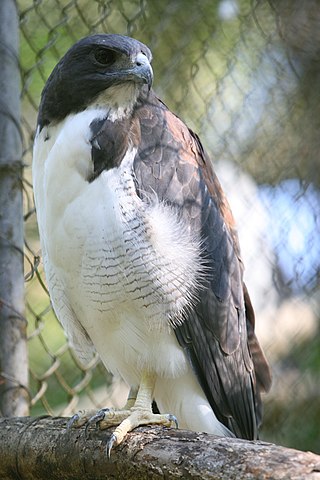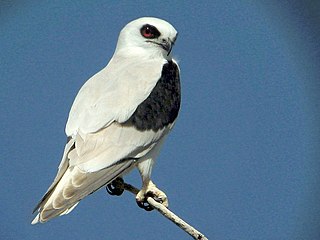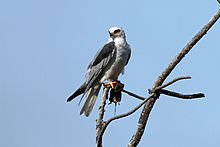
Kite is the common name for certain birds of prey in the family Accipitridae, particularly in subfamilies Milvinae, Elaninae, and Perninae. The term is derived from Old English cȳta, from the Proto-Indo-European root *gū- , "screech."

The black-winged kite, also known as the black-shouldered kite, is a small diurnal bird of prey in the family Accipitridae best known for its habit of hovering over open grasslands in the manner of the much smaller kestrels. This Palearctic and Afrotropical species was sometimes combined with the Australian black-shouldered kite and the white-tailed kite of North and South America which together form a superspecies. This kite is distinctive, with long wings; white, grey and black plumage; and owl-like forward-facing eyes with red irises. The owl-like behaviour is even more pronounced in the letter-winged kite, a nocturnal relative in Australia. Although mainly seen on plains, they are sometimes seen on grassy slopes of hills in the higher elevation regions of Asia. They are not migratory, but show nomadism in response to weather and food availability. They are well adapted to utilize periodic upsurges in rodent populations and can raise multiple broods in a single year unlike most birds of prey. Populations in southern Europe have grown in response to human activities, particularly agriculture and livestock rearing.

The black-shouldered kite, also known as the Australian black-shouldered kite, is a small raptor found in open habitats throughout Australia. It resembles similar species found in Africa, Eurasia and North America, including the black-winged kite, a species that has in the past also been called "black-shouldered kite". Measuring around 35 cm (14 in) in length, with a wingspan of 80–100 cm (31–39 in), the adult black-shouldered kite has predominantly grey-white plumage and prominent black markings above its red eyes. It gains its name from the black patches on its wings. The primary call is a clear whistle, uttered in flight and while hovering. It can be confused with the related letter-winged kite in Australia, which is distinguished by the striking black markings under its wings.

The broad-winged hawk is a medium-sized hawk of the genus Buteo. During the summer, some subspecies are distributed over eastern North America, as far west as British Columbia and Texas; they then migrate south to winter in the Neotropics from Mexico south to southern Brazil. Other subspecies are all-year residents on Caribbean islands. As in most raptors, females are slightly larger than males. Broad-winged hawks' wings are relatively short and broad with a tapered, somewhat pointed appearance. The two types of coloration are a dark morph with fewer white areas and a light morph that is more pale overall. Although the broad-winged hawk's numbers are relatively stable, populations are declining in some parts of its breeding range because of forest fragmentation.

The black wheatear is a wheatear, a small passerine bird in the Old World flycatcher family Muscicapidae. It is found in southern Spain and western North Africa.

Elanus is a genus of bird of prey in the elanine kite subfamily. It was introduced by the French zoologist Jules-César Savigny in 1809 with the black-winged kite as the type species. The name is from the Ancient Greek elanos for a "kite".

An elanine kite is any of several small, lightly-built raptors with long, pointed wings.

The plumbeous kite is a bird of prey in the family Accipitridae that is resident in much of northern South America. It is migratory in the northern part of its range which extends north to Mexico. It feeds on insects which it catches either from a perch or while in flight.

The swallow-tailed kite is a pernine raptor which breeds from the southeastern United States to eastern Peru and northern Argentina. It is the only species in the genus Elanoides. Most North and Central American breeders winter in South America where the species is resident year round.

The pearl kite is a very small raptor found in open savanna habitat adjacent to deciduous woodland. It is the only member of the genus Gampsonyx. The scientific name commemorates the English naturalist William Swainson.

The Mississippi kite is a small bird of prey in the family Accipitridae. Mississippi kites have narrow, pointed wings and are graceful in flight, often appearing to float in the air. It is common to see several circling in the same area.

The white-tailed hawk is a large bird of prey species found in tropical and subtropical environments of the Americas.

The letter-winged kite is a small, rare and irruptive bird of prey that is found only in Australia. Measuring around 35 cm (14 in) in length with a wingspan of 84–100 cm (33–39 in), the adult letter-winged kite has predominantly pale grey and white plumage and prominent black rings around its red eyes. Its name derives from its highly distinctive black underwing pattern of a shallow 'M' or 'W' shape, visible when in flight. This distinguishes it from the otherwise similar black-shouldered kite. This species is also the only nocturnal species within the order Accipitriformes despite few differences found in its visual anatomy to other closely related kites.

The chestnut-vented warbler, chestnut-vented tit-babbler or rufous-vented warbler is an Old World warbler.

The scissor-tailed kite, also known as African swallow-tailed kite or fork-tailed kite, is a bird of prey in the monotypic genus Chelictinia in the family Accipitridae. It is widespread in the northern tropics of Africa.

The white-fronted falconet, also called the Bornean falconet, is a species of bird of prey in the family Falconidae. Described by the British ornithologist Richard Bowdler Sharpe in 1879, it is endemic to Borneo, where it is found in Sarawak, Sabah, and extreme northeastern Kalimantan. An extremely small falcon, it is only 14–17 cm (5.5–6.7 in) long and weighs 35–65 g (1.2–2.3 oz), being the smallest species of falconet. It has glossy bluish-black upperparts, black flanks and outer thighs, and a black mask. The belly and vent are pale yellowish-brown, while the throat, cheeks, and breast are white. The species can be told apart from other falconets by the colour of its crown and forehead, which is white in males and reddish-brown in females. It has no subspecies.

The common black hawk is a bird of prey in the family Accipitridae, which also includes the eagles, hawks, and vultures.

The gray hawk or Mexican goshawk is a smallish raptor found in open country and forest edges. It is sometimes placed in the genus Asturina as Asturina plagiata. The species was split by the American Ornithological Society (AOU) from the gray-lined hawk. The gray hawk is found from Costa Rica north into the southwestern United States.

The red-shouldered hawk is a medium-sized buteo. Its breeding range spans eastern North America and along the coast of California and northern to northeastern-central Mexico. It is a permanent resident throughout most of its range, though northern birds do migrate, mostly to central Mexico. The main conservation threat to the widespread species is deforestation.
Nauclerus was a genus of birds of prey, containing the African and American swallow-tailed kites. Though similar, the two species are not closely related, belonging to separate subfamilies Elaninae and Perninae.























